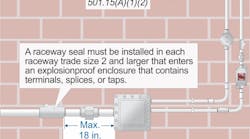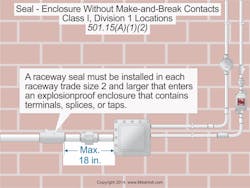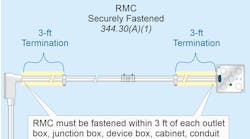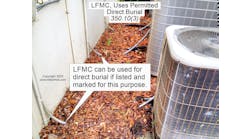Q. What are the Code’s installation requirements for raceway seals in Class I locations?
A. Raceway and cable seals must comply with the requirements set forth in Sec. 501.15. As outlined in Note 1 of this Section, raceway and cable seals must be installed to:
- Minimize the passage of gases and vapors from one portion of electrical equipment to another through the raceway or cable.
- Minimize the passage of flames from one portion of electrical equipment to another through the raceway or cable.
- Limit internal explosions to within the explosionproof enclosure.
In Class I, Div. 1 locations, raceway seals must be located as follows:
Entering enclosures — a raceway seal is required in each raceway that enters an explosionproof enclosure if either (1) or (2) apply:
1) A raceway seal fitting must be installed in each raceway that enters an explosionproof enclosure that contains make-and-break contacts. A seal must also be provided where the enclosure contains equipment that operates at over 80% of the autoignition temperature of the gas or vapor in the area.
Exception: A raceway seal isn’t required if the make-and-break contacts are:
a. Within a hermetically sealed chamber
b. Immersed in oil in accordance with Sec. 501.115(B)(1)(2)
c. Enclosed within a factory-sealed explosionproof chamber
2) A raceway seal fitting isn’t required for trade size ½, ¾, 1, 1¼, or 1½ raceways that enter an explosionproof enclosure that doesn’t contain any make-and-break contacts (junction and splice boxes). An example is an enclosure that only contains terminals, splices, or taps. However, a trade size 2 or larger raceway that enters any explosionproof enclosure must have a raceway seal fitting installed within 18 in. of the explosionproof enclosure (Figure).
When a raceway enters an enclosure that doesn’t contain make-and-break contacts, the raceways only require a seal if they’re trade size 2 or larger.
The raceway seal fitting must be installed within 18 in. of the explosionproof enclosure.
Only explosionproof unions, couplings, reducers, elbows, capped elbows, and conduit bodies are permitted between the raceway seal and the explosionproof enclosure.
Pressurized enclosures — a raceway seal fitting must be installed in each raceway that isn’t pressurized where the raceway enters a pressurized enclosure. The raceway seal fitting must be installed within 18 in. of each raceway that terminates to the pressurized enclosure.
Between explosionproof enclosures — a single raceway seal is permitted between two explosionproof enclosures containing make-and-break contacts if the raceway seal fitting is located not more than 18 in. from either explosionproof enclosure.
Class I, Div. 1, boundary seal — a raceway seal fitting must be installed in each raceway that leaves a Class I, Div. 1 location within 10 ft of the Class I, Div. 1 location on either side of the boundary. There must be no fitting, except for a listed explosionproof reducer installed at the raceway seal fitting, between the raceway seal fitting and the point at which the raceway leaves the Class I, Div. 1 location.
Exception No. 1: A raceway boundary seal fitting isn’t required for a raceway that passes completely through the Class I, Div. 1 area unbroken with no fittings installed within 1 ft of either side of the boundary.
Exception No. 2: If the raceway boundary is below grade, the raceway seal can be located above grade, after the raceway emerges from below grade.
In Class I, Div. 2 locations, raceway seals must be located as follows:
Enclosures with make-and-break contacts — a raceway seal fitting must be installed in each raceway that enters an enclosure that must be explosionproof and that contains make-and-break contacts. The seal fitting must be installed within 18 in. of the explosionproof enclosure.
Boundary seal at unclassified location — a raceway seal fitting must be installed in each raceway leaving a Class I, Div. 2 location. It can be installed on either side of the boundary within 10 ft of the Class I, Div. 2 area. Except for listed explosionproof reducers installed at the raceway seal fitting, there must be no union, coupling, box, or fitting between the raceway seal fitting and the point at which the raceway leaves the Div. 2 location. Raceway boundary seals aren’t required to be explosionproof, but must be identified for the purpose of minimizing the passage of gases permitted under normal operating conditions, and they must be accessible. See the definition of “accessible” as it relates to wiring methods in Art. 100. The raceway boundary seal at unclassified locations is used to minimize the passage of gases or vapors, not to contain explosions in the raceway system.
Exception No. 1: A raceway boundary seal fitting isn’t required for a raceway that passes completely through the Class I, Div. 2 area unbroken with no fittings installed within 1 ft of either side of the boundary.
Exception No. 2: A raceway boundary seal fitting isn’t required for raceways that terminate in an unclassified location where the metal conduit transitions to cable trays, cable bus, ventilated busways, MI cable, or open wiring if:
1) The unclassified location is located outdoors or the unclassified location is indoors and the conduit system is entirely in one room.
2) The raceways must not terminate at an enclosure containing an ignition source in normal operation.
Exception No. 3: A boundary seal fitting isn’t required for a raceway that passes from an enclosure or a room that’s unclassified, as a result of pressurization, into a Class I, Div. 2 location.
If explosionproof sealing fittings are required in Class I, Div. 1 and 2 locations, they must comply with the following: Exception: Boundary seals for Class 1 Div. 2 locations that aren’t required to be explosionproof [501.15(B)(2)] aren’t required to comply with 501.15(C).
Fittings — raceway seal fittings must be listed for the specific sealing compounds and Class I location, and must be accessible.
Compound — the raceway seal compound must be mixed and installed in accordance with manufacturer’s instructions so it minimizes the passage of gases and/or vapors through the sealing fitting. Note: The sealing compound must be from the same manufacturer as the raceway seal.
Thickness of compounds — except for listed cable sealing fittings, the thickness of the raceway seal compound installed in completed seals, other than listed cable sealing fittings, must not be less than the trade size of the seal fitting, but in no case less than 5⁄8 in.
Splices and taps — splices and taps must not be made within a raceway seal fitting.
Number of conductors or optical fiber cables — the conductor or optical fiber tube cross-sectional area must not exceed 25% of the cross-sectional area of rigid metal conduit (RMC) of the same trade size, unless the seal is specifically identified for a higher percentage fill. Note: The cross-sectional area of intermediate metal conduit (IMC) is approximately 7% greater than that of RMC because the wall thickness of IMC is less than RMC. If the cross-sectional area of IMC is used for conductor fill calculations, the 25% of “RMC conductor fill” can be exceeded.
In Class I, Div. 1 locations, cable seals must be located as follows:
Terminations — Type MC-HL cable is inherently gas/vaportight by the construction of the cable, but the termination fittings must permit the sealing compound to surround each individual insulated conductor to minimize the passage of gases or vapors. Exception: The removal of shielding material or the separation of the twisted pairs isn’t required within the raceway seal fitting.
Cables capable of transmitting gases or vapors in a raceway — raceways containing cables must be sealed after removing the jacket and any other coverings so that the sealing compound surrounds each individual insulated conductor or optical fiber tube in a manner so as to minimize the passage of gases and vapors. Exception: The removal of shielding material or the separation of the twisted pairs isn’t required within the raceway seal fitting.
Cables not capable of transmitting gases or vapors in a raceway — each multiconductor cable installed in a raceway is considered to be a single conductor if the cable is incapable of transmitting gases or vapors through the cable core.
In Class I, Div. 2 locations, cable seals must be located as follows: Exception: Seals aren’t required in a Class 1 Div. 2 location if the cable passes through the location and has an unbroken gas or vaportight sheath.
Multiconductor cable — multiconductor or optical fiber cables that enter an explosionproof enclosure must be sealed after removing the jacket and any other coverings so that the sealing compound will surround each individual insulated conductor or optical fiber tube in a manner so as to minimize the passage of gases and vapors.
Multiconductor cables or optical fiber cables installed in a raceway must be sealed in accordance with 501.15(D)(2) or (3). Exception No. 2: The removal of shielding material or the separation of the twisted pairs isn’t required within the cable seal fitting.
Cable seal-boundary — cables without a gas/vaportight continuous sheath must be sealed at the boundary of the Class I, Div. 2 location in a manner so as to minimize the passage of gases or vapors into an unclassified location.





